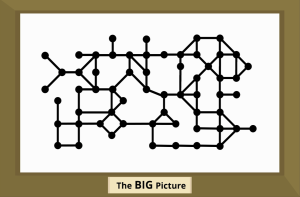The Use of Narrative Structure in Course Design

Whatever the objective, knowing one’s goal is key to achieving it. This simple adage is the essence of backward design and helps in building modules that prepare students for success. But modules don’t exist in isolation in online courses. Rather, they’re part of a larger structure that students will experience as one class.
Constructing your modules gives you an opportunity to articulate the relationship between them as part of a broader journey that scaffolds and connects to prior knowledge. By weaving context, themes, or a story—a narrative—into the course structure, you can increase student engagement and emotional connection to the material, thus contributing to a lasting, transferrable, and meaningful learning experience.
Why Narrative?
Modules in an online course function similarly to chapters in a book in that they arrange subject matter in a logical, orderly way. But they also provide a high-level organizational framework that can guide students toward understanding. Understanding how the brain receives and organizes information is key to realizing the potential of narrative for engaging online students.
According to John Hattie and Greg Yates (2014), students instinctively build mental models, or schema, to structure knowledge and make sense of seemingly disparate parts in the context of what they know. However, cognitive science has shown that the brain does not learn linearly. Joanna Szurmak and Mindy Thuna (2013) suggest that the learning brain is better represented by a fractal, through which multiple connections, layers, and views are simultaneously possible. “Using stories,” they claim, “may layer and activate patterns and set up an affectively charged structure to which students will instinctively respond and with which they will interact” (p. 549).

In other words, students will embed details in a big-picture view similar to how they already experience the world, where basic literary elements such as setting, plot, theme, imagery, and characters already exist in their personal lives. Build a setting of curiosity, develop plots of discovery, relate common themes, reinforce concepts with imagery, and encourage students to become actors in the unfolding of the class. Any of these are narrative approaches to teaching, which, according to M. Carolyn Clark (2010), “connects experiential learning and the notion of narrative as a sense-making medium” (p. 5).
Types of Narrative Structure
An online course doesn’t need to be as complex as a video game or as eloquent as a Shakespearean sonnet to include narrative elements that aid students in connecting to your content and building their mental schema. At a minimum, a thoughtful grouping and sequencing of modules facilitates the construction of a meaningful “story” of what students should learn and why. Through your course structure, you invite students to create their mental models at the level of core ideas, which is where deep learning can occur.
One common way to segment course content into modules is to follow textbook chapters, in which authors and publishers have already arranged subject matter. However, other options both allow you more creativity and give you increased control over the breakdown and sequence of your content. Consider how the following patterns might guide a course structure:
| Pattern | Description | Example |
|---|---|---|
| Chronological (or reverse chronological) order | By date of discovery, invention, or maturation | An American history course begins in the present, establishing students as time travelers on a reverse chronological journey. |
| Sequential order | By order of steps or order of importance | A political science course introduces topics as they arise in the unfolding an election campaign or in an immigrant’s application for citizenship. |
| Funneling | From the foundational to the complex or from an overview into its constituencies | An educational leadership course guides students in creating an alternative school system from the ground up. |
| Geographical or spatial grouping | By location or proximity | A business course apprentices students to a corporate vision or visionary from founding to failure or success. |
| Ideological grouping | By systems, genres, or schools of thought | A science course organizes topics by the lives of renowned researchers of discovery’s frontiers. |
| Problems and solutions | By questions or avenues of inquiry | A mathematics course opens each module with a dilemma that the course’s mathematical formulae solve. |
Any of these course structures offer the potential for embedding a discipline’s details into a narrative context. Not only can they incite the imagination and ignite affective areas of the brain, but also, as Tracey Tokuhama-Espinosa (2010) explains it, it’s simply how the brain learns best.
Conclusion
A modular structure contains a framework for arranging your course content logically and consistently. These structures not only diminish the chance that students will get lost in the course, but also provide a ready-made schema for big-picture understanding. When narrative is layered into a course structure, learning becomes embedded in a more natural context that engages students affectively as well as cognitively. This type of engagement helps them retain details and make meaning of information and also increases the impact of and learning potential in your course.
References
Clark, M. C. (2010). Narrative learning: Its contours and its possibilities. New Directions for Adult and Continuing Education, 2010(126), 3–11.
Hattie, J., & Yates, G. (2014). Visible learning and the science of how we learn. New York: Routledge.
Szurmak, J., & Thuna, M. (2013). Tell me a story: The use of narrative as a tool for instruction. Conference of the Association of College and Research Libraries, April 10–13, 2013, Indianapolis, IN. Retrieved from http://www.ala.org/acrl/acrl/conferences/2013/papers
Tokuhama-Espinosa, T. (2010). The new science of teaching and learning: Using the best of mind, brain, and education science in the classroom. New York: Teachers College Press.
